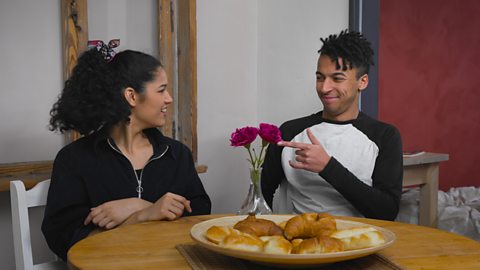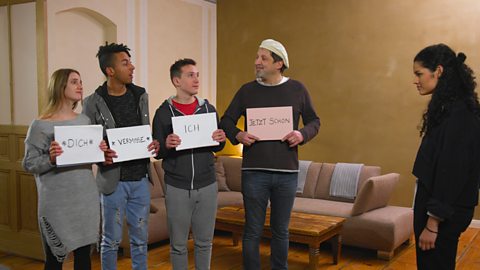German has three genders (feminine, masculine and neuter) for nouns and an additional one for plural nouns, but how do you know which gender is correct? Watch this video for some clues and hints to help you.
Makeda wants to go shopping with her newly earned money, but before she starts spending she needs to figure out how to tell which gender a word is. Luckily, Rapper has some easy tips.
Makeda: This shop is super cool. Die Laden ist super schön!
Rapper: Der Laden ist super schön! We have three genders: masculine, feminine and neuter, so like neutral. In German every single object, thing or person has one. And if it's a group, plural, we've got a special one for that too.
Makeda: So in German, things have gender? What, like everything?
Rapper: Pretty much.
Makeda: But what, I've got to look up every single one?
Rapper: Uh yes.
Makeda: What?!
Rapper: But there are some clues.
Makeda: Oooh. Okay. Ich bin ein Mädchen It's got a '-chen' at the end, so I know it has to be neuter, even though I'm a girl. Got it. But what about feminine and masculine?
Rapper: Well, they've got some clues too. There's the masculine, 'ling' or 'ig-mus', and the feminine, 'heit-ung-keit-schaft-tion-ei'.
Makeda: Okay! The radiator: die Heizung. It's got '-ung' at the end, so it's got to be feminine! Du hast eine Heizung.
Rapper: Ganz genau!
Makeda: Bäckerei, bakery. It's got an '-ei' at the end, so I know it's got to be feminine!
Rapper: Die Bäckerei ist wunderbar. The bakery is wonderful, yes!
Makeda: The table is small. Der Tisch ist klein. Ich sehe ein Tisch. What? Why?! What's wrong with 'Ich sehe ein Tisch?!'
Rapper: Something strange happens when masculine words aren't doing the action, but are the object of the action. They still want to stand out, so they change their ending. And in German, whoever does the action in the sentence, they are number one.
Makeda: What? Even if the thing doing the action is a donkey? Or a fridge?
Rapper: Uh, even then, yes. Anyway! So in your sentence, 'Ich sehe einen Tisch,' 'I see a table,' who is doing the action?
Makeda: I am.
Rapper: Richtig! Du machst das! You're doing the seeing. So in that sentence, you're number one. And the table, well, that's the thing you're doing the action to, so it's your number two. You're doing the action, you're number one. It's the thing you're doing the action to that is your number two.
Makeda: So 'ein Tisch' is when it's number one in the sentence, but 'einen Tisch' is when it's number two. Ich sehe einen Tisch. What about a shoe? Der Schuh. Masculine. Der Schuh ist schwarz. The shoe is black. It's number one. But if I say, 'I have a shoe' that will change. Ich habe einen Schuh.
Rapper: Du hast einen Schuh, ganz genau!
Makeda: Hey, wait a second, though. Those were all masculine. What about feminine and neuter? And the plural?
Rapper: Well, they're pretty easy. They don't change when they're number two.
Makeda: What, not at all?
Rapper: Nope, they don't change. Sie ändern sich nicht. So like, 'die Katze', right? It's feminine. 'Die Katze ist suß', the cat is cute. 'Eine Katze ist suß', a cat is cute. It's the one doing the action, it's being cute, it's number one. But if I say 'I have a cat', I have it, I'm Mr Number One, and the cat is my number two, but it stays as 'eine'.
Makeda: Ich habe einen Cousin. Der Cousin ist nett. Du hast eine Schlange.
Rapper: Haha.
Makeda: Die Schlange ist gefährlich. Du hast ein Album Das Album ist neu. Flash! Winning!
GCSE exam dates 2025
Find out everything you need to know about the 2025 GCSE exams including dates, timetables and changes to exams to get your revision in shape.

More on Everyday language
Find out more by working through a topic
- count3 of 10

- count4 of 10

- count5 of 10

- count6 of 10
